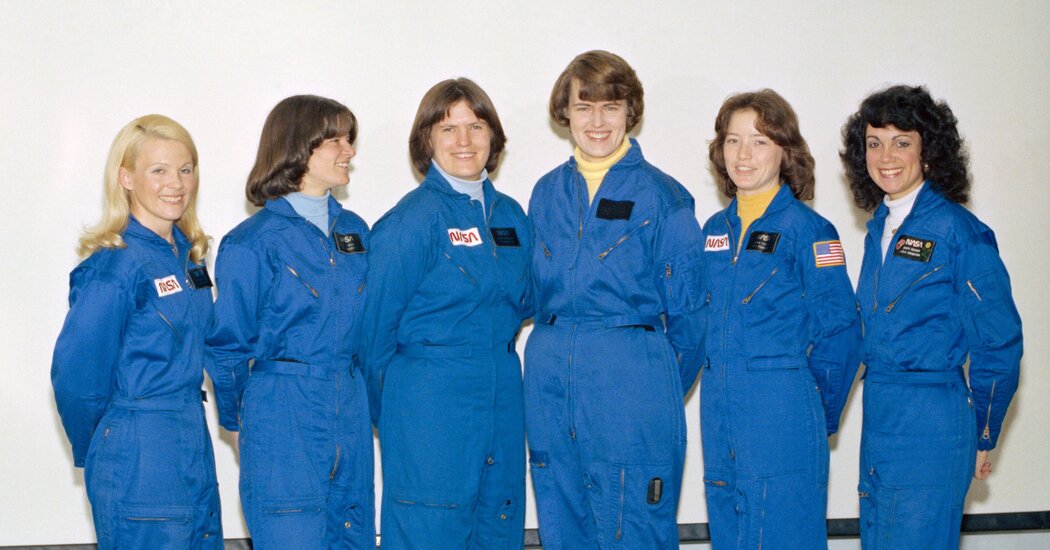THE SIX: The Untold Story of America’s First Women Astronauts, by Loren Grush
It’s difficult to imagine a place more coded as masculine than the cockpit of a rocket ship. The tales of the space race enshrined in American history too often center on white men and elevate machismo. From the first pages of “The Six: The Untold Story of America’s First Women Astronauts,” the science journalist Loren Grush reclaims this place as female.
“The Six” opens with a quiet scene. Anna Fisher, eight months pregnant with her daughter, takes an overnight shift in the space shuttle Challenger on June 17, 1983, guarding its switches and buttons in advance of the morning launch. A pregnant astronaut, writes Grush, had never before been possible; astronauts had all been men. It’s a midnight vigil, but not a solitary one: The next generation dwells there, too.
Fisher wouldn’t fly that morning. The honor of being first would go to Sally Ride. But Grush insists on equal recognition for the five women who followed her: Judy Resnik, Kathy Sullivan, Fisher, Rhea Seddon and Shannon Lucid. “The Six” joined NASA’s astronaut corps in 1978, the first class to allow women. Though each flew to space separately, they were a cohort, who knew their successes or failures would shape the destinies of generations of women to come.
Grush skillfully weaves a story that, at its heart, is about desire: not a nation’s desire to conquer space, but the longing of six women to reach heights that were forbidden to them — literally, to fly.
When the Soviet Union put the first man in space in 1961, the United States rallied to repeat the feat just 23 days later. The first Soviet woman in space, Valentina Tereshkova, spurred no similar surge in innovation; instead, American journalists derided her “plump figure” and lack of lipstick. NASA’s insistence on using military test pilots for astronauts was a de facto ban of women, as were deeply held beliefs about what the astronaut John Glenn termed “a fact of our social order.”
Then NASA developed the space shuttle, meant to be “a paradigm-changing transition from something dangerous and expensive to an endeavor that was cheap, routine and safe.” With the shuttle came a new type of astronaut, “mission specialists” who could be scientists, engineers or doctors. In 1976, pushed by champions for diversity both inside and outside the agency, NASA invited women to apply.
A six-pronged biography is necessarily sweeping rather than intimate, and it’s hard not to want to know more about each woman’s motivations and hesitations. Grush’s richly researched account shines when she can offer those insights. She dwells on the precise moment when each of the Six realized she could apply to be an astronaut, the fulfillment of a childhood dream. The 1978 class, though dominated by 25 white men, “was the closest NASA had ever come,” Grush writes, “to picking astronauts who reflected the true makeup of America.”
She resists the urge to put the Six on a pedestal, and avoids Hollywoodizing their relationships with one another. They were neither close friends nor fierce competitors, Grush writes, but rather “trusted co-workers” who “could form a united front when they needed.”
They confronted sexist news media attention — often with cool logic, though Resnik stands out for her delightful snark — and dealt with chauvinist speculation about romance and sex in space. Ride’s story shines, not because she was first, but for her battle to protect her privacy and mental health amid the media frenzy. Fisher, too, gives a glimpse of the sometimes painful tension between the personal and professional; preparing for a dramatic shuttle mission to retrieve two failed satellites, she sneaks away from Mission Control to pump breast milk.
“The Six” also offers brief but poignant roles to champions such as Ruth Bates Harris, a NASA employee who bravely blasted her superiors for their “near-total failure” in welcoming diversity; the Mercury 13, a group of women who underwent rigorous physical and psychological testing in 1960-61 to prove they could meet the requirements to be astronauts; and Nichelle Nichols (Lieutenant Uhura from “Star Trek”), who declared in a NASA recruitment video: “I’m speaking to the whole family of humankind — minorities and women alike.”
The day-to-day work of the astronauts — surprisingly mundane — makes for fascinating reading. The women test spacesuits, maneuver a robotic arm and work out the quirks of interacting with male colleagues who keep pinup calendars on their office doors. The spaceflights themselves contain plenty of drama and danger.
Anyone familiar with the 1986 Challenger disaster will feel a chill when Grush first mentions the rubber O-rings meant to prevent catastrophic explosions during launch. Delicate foreshadowing reminds readers that — despite NASA’s goal to make space travel “cheap, routine and safe” — complex engineering always involves risk. Resnik ultimately gave her life for the dream of spaceflight.
It’s daring to end a book on tragedy rather than triumph. But it adds heartbreaking emphasis to Grush’s point: “Courage and perseverance in the most pressure-filled situations,” she writes, “aren’t traits that are exclusive to a single gender or race.”
Like space travel itself, “The Six” widens our vision of what it means to belong to “the whole family of humankind.”
Melissa L. Sevigny is a science journalist and author of three books, most recently “Brave the Wild River.”
THE SIX: The Untold Story of America’s First Women Astronauts | By Loren Grush | 432 pp. | Scribner | $32.50











